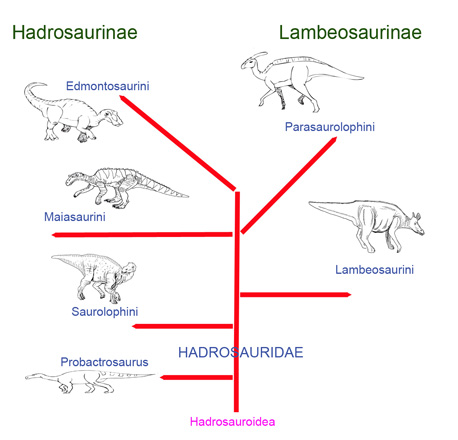The Wandering Duck-billed Dinosaur a New Clade of within the Hadrosauridae
Early Duck-billed Dinosaur Discovery Adds to Debate over Evolution of Hadrosauridae Crests
Scientists have a new clade of duck-billed dinosaur to study, and thanks to two almost simultaneous fossil discoveries in the United States; more information on the evolution of Hadrosauridae head crests could emerge as well as a better understanding of the geographical distribution of ornithischian genera in the western United States during the Late Cretaceous.
Duck-billed Dinosaur
The duck-billed dinosaurs, so called as they had beaks that resembled the broad beaks of a duck, were a very successful group of plant-eating dinosaurs that evolved during the Cretaceous and rapidly diversified into numerous genera. These types of dinosaur are broadly divided into two main sub-families, the hollow crested Lambeosaurinae and the predominately solid crested or crest absent – Hadrosaurinae. The discovery of a new genus of duck-billed dinosaur named Acristavus gagslarsoni has led to the establishment of a new clade of hadrosaurs, the Brachylophosaurini and may shed light on the origins of these dinosaurs and how they diversified into two main sub-families.
Acristavus gagslarsoni
The first fossil specimen was found in Montana in 1999 by the Old Trail Museum staff and volunteers, including a group of “junior palaeontologists” from the University of Chicago and was excavated in 2001 and 2002 from the Two Medicine Formation (Montana) by study co-author Rebecca Hanna for the Museum of the Rockies in Bozeman, Montana, where it now resides. By an extraordinary coincidence, a second specimen of the same dinosaur species was discovered just a a year after the Montana specimen (2000).
This discovery was made in the Grand Staircase Escalante National Monument strata (Wahweap Formation – southern Utah) by an entomologist from Brigham Young University C. Riley Nelson (who has also co-authored the published paper on this new dinosaur with Rebecca).
The strata at these two sites date from the same geological time (Campanian faunal stage) and the two finds have been dated to approximately 79 million years ago. This makes A. gagslarsoni the oldest known hadrosaur from North America and it is remarkable that two specimens of the same dinosaur species were found within a year of each other, but at locations more than six hundred miles apart.
A Wandering Hadrosaur
Terry Gates, a research associate at the Chicago Field Museum stated:
“To find two specimens six hundred and fifty miles apart that lived at virtually the same time, and were discovered within a year of each other is extremely rare in dinosaur palaeontology”.
With elements of the skull to study including the frontal and postorbital bones along with the dentary (lower jaw) scientists have noted that there is a lack of any cranial ornamentation (no crest), which is in stark contrast to virtually every other of genus of hadrosaur dinosaur discovered to date. This discovery, an early type of hadrosaur, what is believed to be a basal North American duck-billed dinosaur lacking any form of head crest or ornamentation adds weight to the theory that the two sub-families of this type of dinosaur, the Lambeosaurinae and the Hadrosaurinae independently evolved head crests and ornamentation.
As for explaining why the fossils were found so far apart a spokesperson for Everything Dinosaur commented:
“There could be a number of reasons why these specimens were found so far apart. For example, most scientists believe that these dinosaurs lived in herds and they may have made extensive migrations in search of seasonal feeding opportunities or indeed travelling to favoured nesting sites. Secondly, this type of basal hadrosaur may have had a wide geographical distribution, perhaps it had an inherent advantage over other types of plant eating dinosaur around at the time, which made this particular type or herbivore very successful.”
A Simplified Hadrosaur Family Tree
Picture credit: Everything Dinosaur
The Brachylophosaurini consists of three hadrosaur genera, Acristavus plus Maiasaura, whose fossils have also been found in Montana and Brachylophosaurus from which the clade gets its name. This dinosaur was again widely distributed with a known range from Montana in the south to Alberta (Canada), in the north. These dinosaurs together constitute the earliest clade of North American hadrosaurs.
The Acristavus fossils indicate that this dinosaur had anatomical characteristics seen in both Brachylophosaurus and Maiasaura specimens, but not necessarily shared between them. This suggests that Acristavus may be ancestral to these other dinosaur genera
To view models and replicas of duck-billed dinosaurs including members of the Hadrosaurinae: Hadrosaurinae Dinosaur Models and Prehistoric Animal Figures.


